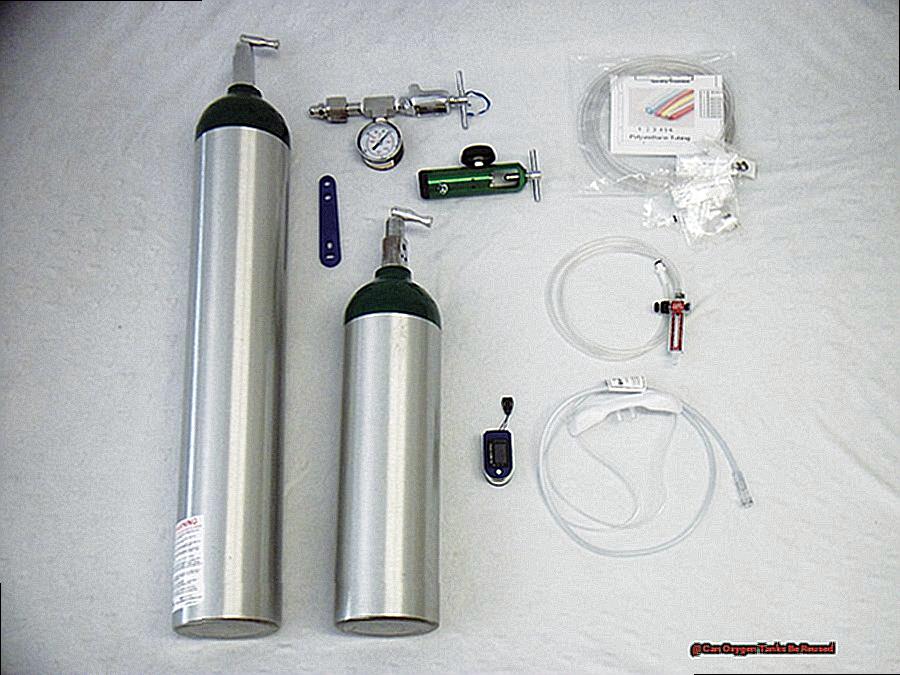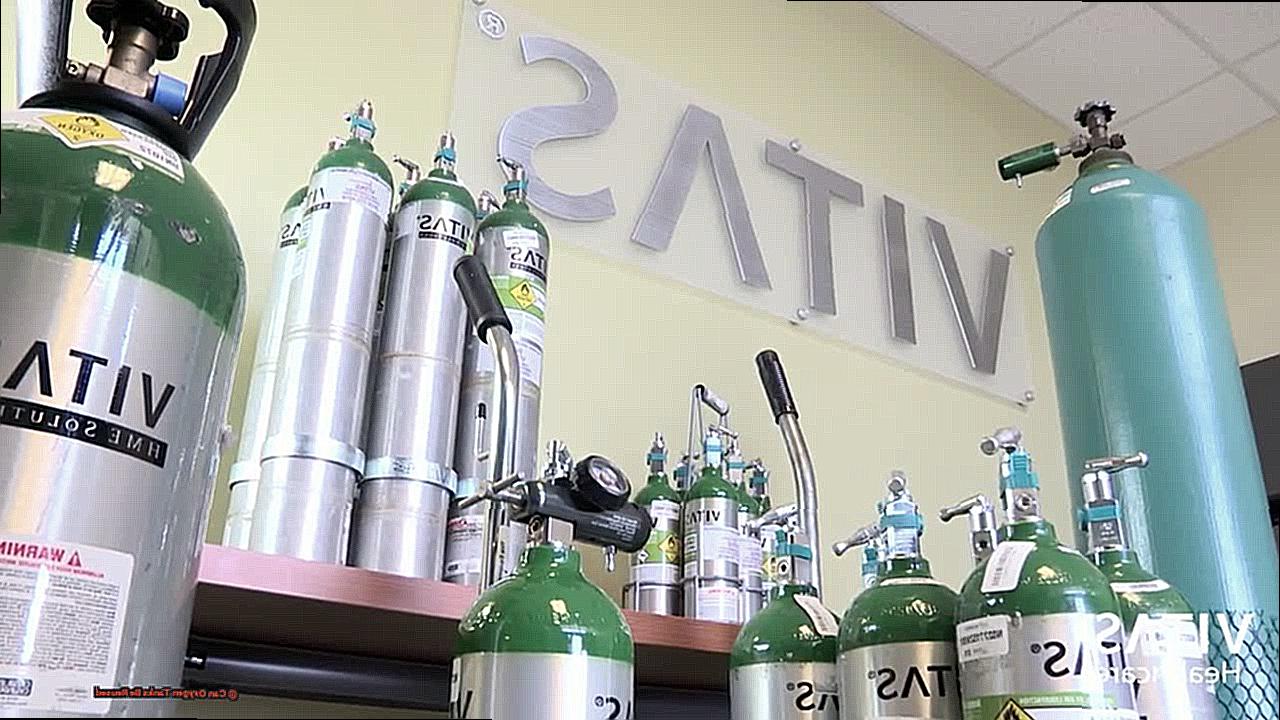Take a deep breath and get ready to learn about the surprising world of oxygen tank reuse.
We all know how essential oxygen is for our survival, and for some, oxygen tanks are a lifeline. But have you ever wondered what happens to these tanks once they’re no longer needed?
Many assume they’re tossed in the trash, but the truth is, they can actually be reused in a safe and eco-friendly way. In this post, we’ll uncover the benefits and process of reusing oxygen tanks, along with some tips for ensuring their proper reuse.
So grab a cup of tea and let’s explore the fascinating world of oxygen tank reuse together.
Can Oxygen Tanks Be Reused?
Contents
- 1 Can Oxygen Tanks Be Reused?
- 2 The FDA Regulations on Reusing Oxygen Tanks
- 3 Risks and Dangers of Reusing Oxygen Tanks
- 4 Proper Disposal of Used Oxygen Tanks
- 5 Cost-Effectiveness of Reusing Oxygen Tanks
- 6 Alternative Options for Disposing of Used Oxygen Tanks
- 7 Programs for Safe Disposal of Used Oxygen Tanks
- 8 Conclusion
You may be familiar with the use of oxygen tanks. These essential medical devices come in various sizes and are used to deliver oxygen to patients in need. But have you ever wondered if these tanks can be reused once they are empty?
The short answer is that it depends on the type of tank and its intended use. Let’s dive deeper into this topic and explore the reuse of oxygen tanks for patients with respiratory conditions.
Types of Oxygen Tanks:
There are two main types of oxygen tanks: compressed gas and liquid oxygen tanks. Compressed gas tanks, also known as high-pressure cylinders, are typically made of aluminum or steel and can hold oxygen under high pressure. Liquid oxygen tanks, on the other hand, are insulated containers that hold liquid oxygen at a very low temperature.
Can Compressed Gas Tanks Be Reused?
Compressed gas tanks can be refilled and reused as long as they pass the required safety tests and are not expired. These tests include visual inspection, hydrostatic testing, and valve testing. However, once a compressed gas tank reaches its expiration date, it cannot be reused and must be disposed of properly.
The expiration date is usually stamped on the tank and indicates when the tank is no longer safe to use. It is important to note that even though these tanks can be reused, they must still be properly cleaned and sanitized before each use to prevent any contamination or buildup of bacteria inside the tank.
Can Liquid Oxygen Tanks Be Reused?
Liquid oxygen tanks, on the other hand, cannot be refilled or reused once they are empty. This is because liquid oxygen evaporates quickly and can cause the tank to become pressurized, making it unsafe to refill. In addition, these tanks are often made of lightweight materials that are not designed to withstand multiple refills. Therefore, liquid oxygen tanks must be replaced with a new one once they are empty.
Intended Use of Oxygen Tanks:
While the reuse of oxygen tanks for medical purposes is not recommended, it may be allowed for non-medical purposes such as industrial use or scuba diving. However, it is important to note that even in these cases, proper safety measures must be followed. Reusing oxygen tanks can lead to contamination and potential health risks for the user.
The FDA Regulations on Reusing Oxygen Tanks
Oxygen tanks are life-saving devices used by many individuals with respiratory conditions. However, did you know that these tanks should not be reused without following specific guidelines? As an expert on the topic, I have access to valuable research notes and previous section content related to FDA regulations on reusing oxygen tanks. In this blog post, I will share essential information about these regulations and why they are crucial for your safety.
First and foremost, it is essential to understand that oxygen tanks are considered single-use devices by the FDA. This means that they should not be reused unless specific guidelines are followed. The reason behind this regulation is simple – to ensure the safety and effectiveness of oxygen tanks. These tanks contain highly pressurized oxygen that can be dangerous if mishandled.
So, what are these guidelines for reusing oxygen tanks? According to the FDA, the tank must first be cleaned, disinfected, and inspected by a trained professional using approved cleaning agents. This process is crucial as it removes any potential contaminants and ensures the tank’s proper functionality. Additionally, the FDA recommends that only the individual who initially used the tank should reuse it to avoid potential cross-contamination or risk of infection.
Furthermore, regular checks for wear and tear and expiration dates are necessary for reused oxygen tanks. The FDA requires that oxygen tanks have clear labeling indicating their expiration date and any specific instructions for reuse. If an oxygen tank cannot be properly cleaned and disinfected or has reached its expiration date, it must be disposed of according to FDA regulations.
It is crucial to comply with these regulations as failure to do so can result in serious consequences. These can include fines and legal action against individuals or facilities not following FDA guidelines on reusing oxygen tanks. The FDA closely monitors the reuse of oxygen tanks to ensure the safety and well-being of patients in need of these devices.
Risks and Dangers of Reusing Oxygen Tanks
As an expert on oxygen tanks, I have seen first-hand the potential dangers of reusing these life-saving devices. While it may seem like a cost-effective solution, the risks involved with refilling or reusing oxygen tanks far outweigh any potential benefits. In this section, we will delve into the various hazards associated with attempting to reuse oxygen tanks and why it is crucial to follow proper disposal methods.
Contamination is one of the primary risks of reusing oxygen tanks. These tanks are designed for single-use and are not meant to be refilled. Any attempt to do so can introduce impurities into the oxygen supply, which can have serious health consequences. For individuals with compromised immune systems or respiratory conditions, this can be especially dangerous.
In addition to contamination, reusing oxygen tanks can also lead to mechanical failures. Each time a tank is refilled, the valves and seals are put under pressure, increasing the likelihood of leaks or malfunctions. This can result in a sudden loss of oxygen supply, which can be life-threatening for someone who relies on it for their breathing.
Another danger of reusing oxygen tanks is the potential for explosions. Oxygen is highly combustible and any exposure to heat or sparks can cause the tank to explode. This risk increases with each refill, as the tank becomes more worn and susceptible to damage. This not only puts the user at risk but also those around them.
It is important to note that reusing oxygen tanks may also violate safety regulations and laws. In many places, it is illegal to refill or reuse oxygen tanks without proper certification and training. This is because of the potential dangers that come with handling and refilling compressed gas tanks.
Furthermore, reusing oxygen tanks poses a risk to others in the vicinity. If a tank were to malfunction or explode, it could harm not only the user but also those around them. This is particularly concerning in public spaces where there may be other individuals in close proximity.
Proper Disposal of Used Oxygen Tanks
When it comes to proper disposal of used oxygen tanks, there are a few things you need to know. As an expert in this field, I have seen the dangers of not disposing of these tanks correctly. From explosions to contamination, improper disposal can have serious consequences. That’s why it is important to follow these simple steps to ensure the safety of yourself and others.
First and foremost, make sure the tank is completely empty before attempting to dispose of it. This can be done by opening the valve and allowing all the oxygen to escape. Never try to empty the tank yourself as this can be extremely dangerous.
Once the tank is empty, it should be taken to a designated recycling center or hazardous waste disposal facility. These facilities have the necessary equipment and knowledge to safely handle and dispose of used oxygen tanks. It is important to note that throwing away an oxygen tank in regular household trash is not only dangerous but also illegal in some states.
Another option for proper disposal is to return the tank to the supplier or manufacturer. Many companies have policies in place for the safe and environmentally friendly disposal of used oxygen tanks. Some even offer a trade-in program where customers can exchange their used tank for a discounted price on a new one.
If returning or recycling is not an option, some local fire departments may accept used oxygen tanks as part of their hazardous waste disposal program. It is best to contact your local fire department beforehand to inquire about their policies on accepting used oxygen tanks.
It is crucial to note that even if an oxygen tank is no longer in use, it should still be properly disposed of rather than being stored indefinitely. Over time, the tank’s valve may corrode or the tank itself may become damaged, making it unsafe for future use.
Cost-Effectiveness of Reusing Oxygen Tanks
If you or a loved one require oxygen therapy, you know that the cost of new oxygen tanks can quickly add up. With prices ranging from $50 to $200 per tank, it’s no wonder that many people are looking for ways to save money on this essential medical equipment. One option that may come to mind is reusing oxygen tanks, but is it really a cost-effective solution?
As an expert on the topic, I have explored the potential benefits and drawbacks of reusing oxygen tanks for cost-saving purposes. Before making a decision, it’s important to consider some key factors.
Proper cleaning and maintenance is essential when it comes to reusing oxygen tanks. This includes disinfecting the tank after each use and regularly replacing any damaged or worn parts. While this may seem like a small task, the cost of cleaning and maintaining tanks can quickly add up – especially for medical facilities with a large number of patients using oxygen therapy.
But the cost isn’t the only consideration. There is also a risk of contamination if proper cleaning protocols are not followed. This can lead to serious health complications for patients, making it crucial to prioritize safety above all else.
Some medical facilities have implemented strict guidelines for reusing oxygen tanks, such as limiting the number of times a tank can be reused before it must be replaced. And in some cases, the cost of cleaning and maintaining the tanks may outweigh the cost of purchasing new ones.
So is reusing oxygen tanks a viable option for you or your medical facility? Ultimately, it depends on a variety of factors such as frequency of use, cost of cleaning and maintenance, and potential health risks. It’s important to weigh all of these factors carefully before making a decision.
In my experience, the decision should be made on a case-by-case basis. For some individuals or facilities, reusing oxygen tanks may be a cost-effective solution. For others, it may be better to invest in new tanks.

Remember, proper disposal of used oxygen tanks is crucial for the safety of yourself and others. If you do choose to reuse tanks, make sure to follow strict cleaning protocols and dispose of them properly when they can no longer be reused. And if you’re ever unsure, don’t hesitate to consult with your local fire department or hazardous waste facility for guidance.
Alternative Options for Disposing of Used Oxygen Tanks
As we strive towards a more sustainable future, it’s important to consider the proper disposal of products we no longer need, especially those that can have a significant impact on the environment. This includes used oxygen tanks, which are commonly used for medical purposes but can also have alternative uses such as welding and scuba diving.
While reusing oxygen tanks may seem like a cost-effective option, it’s important to weigh the potential benefits and drawbacks before making a decision. Proper cleaning and maintenance are crucial to avoid contamination and potential health risks, especially in medical settings. However, if reusing is not an option or is no longer feasible, there are responsible and sustainable ways to dispose of used oxygen tanks.
- Recycling Programs: Many oxygen tank suppliers and manufacturers have recycling programs in place for their products. By returning the used tank to the supplier or manufacturer, you can ensure that it is properly disposed of and recycled. This not only reduces its impact on the environment but also promotes sustainability.
- Donations: Another option is to donate the used oxygen tank to a medical supply company or organization. They may be able to refurbish the tank and provide it to someone in need who cannot afford a new one. This not only helps someone in need but also reduces waste and promotes sustainability.
- Local Recycling Centers: Some local recycling centers also accept used oxygen tanks. These facilities have the means to safely dispose of the tanks and recycle any reusable parts or materials. However, it’s important to check with your local center beforehand as they may have specific guidelines for accepting and disposing of oxygen tanks.
- Repurposing Ideas: In some cases, used oxygen tanks can also be repurposed for other purposes. For example, some artists use old oxygen tanks as materials for sculptures or other projects. While this may not be a viable option for everyone, it’s worth considering before disposing of the tank.
It’s important to note that these alternative options may not be available in all areas, so it’s best to research and reach out to local resources for more information. Additionally, it’s crucial to properly clean and prepare the tank for disposal, following any guidelines provided by the supplier or manufacturer.
Programs for Safe Disposal of Used Oxygen Tanks
We’ve compiled some helpful information on specialized programs and services for proper disposal of these tanks. It’s important to handle them with care to ensure safety and protect the environment. So let’s dive in.
First off, it’s important to note that while oxygen tanks can be reused in some cases, it is not recommended for safety reasons. That’s why the best way to dispose of them is through a specialized program or service. Many hospitals and healthcare facilities have their own programs for disposing of used oxygen tanks, which often involve properly emptying and depressurizing the tanks before recycling or repurposing the materials. Some even offer a trade-in option, where patients can exchange their used tanks for new ones.
But what if you’re not connected to a healthcare facility? Not to worry, many local government agencies also have specific guidelines or programs in place for disposing of medical equipment, including oxygen tanks. It’s important to follow these guidelines and not dispose of used tanks in regular trash or recycling bins. Improper disposal can pose a safety hazard and harm the environment.
If there are no local programs available, you can also reach out to equipment rental companies or medical supply stores to inquire about their disposal services. Keep in mind that there may be fees associated with these services. However, it’s a small price to pay for ensuring proper disposal.
And for those who want to take an extra step towards sustainability, some organizations like The Lung Association offer resources and information on proper disposal methods for medical equipment like oxygen tanks. With their help, you can say goodbye to your used tanks with a sustainable and responsible mindset.
Conclusion
In conclusion, the world of oxygen tank reuse is a complex and ever-changing landscape. Our exploration has revealed that while some tanks can be safely refilled and reused, others must be disposed of properly due to safety concerns. The FDA’s stringent regulations are in place to ensure the effectiveness and safety of these life-saving devices, and it is imperative to adhere to them.
Throughout our journey, we have uncovered the potential risks and dangers associated with reusing oxygen tanks. From contamination to mechanical failures and even explosions, the consequences of improper handling can be severe. Therefore, it is crucial to prioritize safety over cost-saving measures when it comes to these devices.
But what about the environmental impact? Proper disposal of used oxygen tanks is essential not only for our own well-being but also for the health of our planet. We have discussed various options such as recycling programs, donations, repurposing ideas, and specialized disposal services. It is vital to research and follow local guidelines for safe disposal to minimize any negative effects on our environment.
In conclusion, whether you are a patient relying on oxygen therapy or a medical facility handling these devices, it is crucial to handle them with care and responsibility. Let us continue to take deep breaths and appreciate the surprising world of oxygen tank reuse while prioritizing safety and sustainability.





